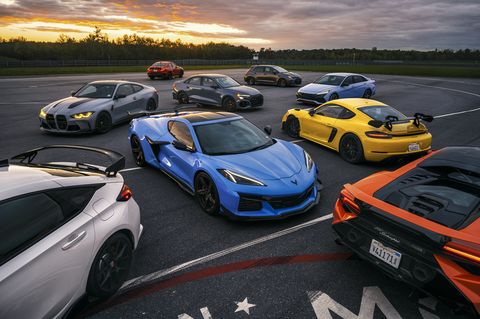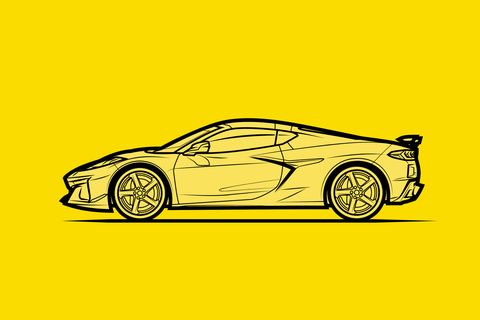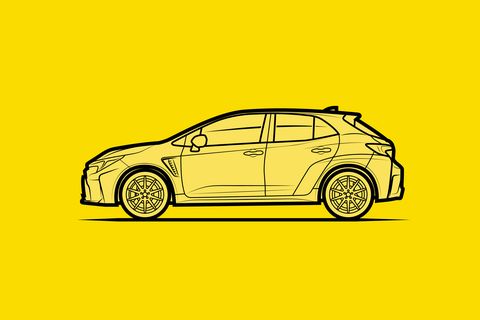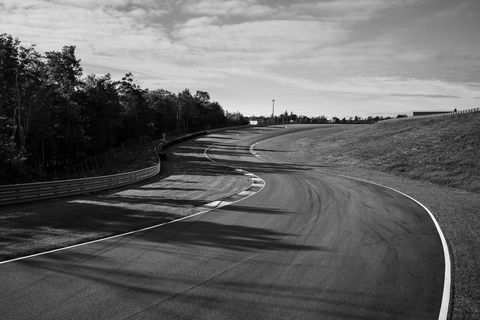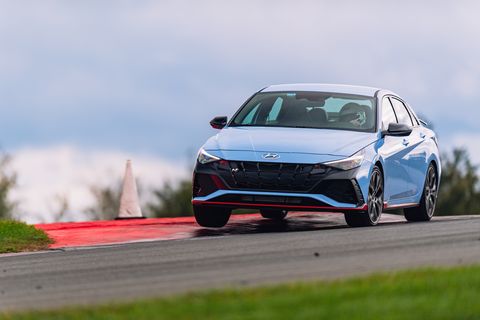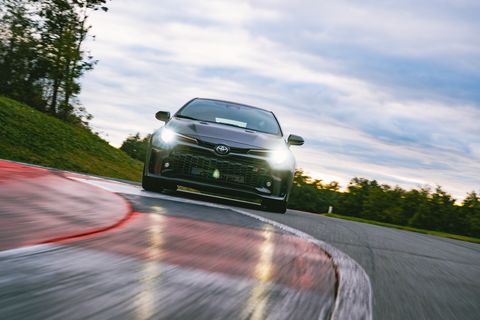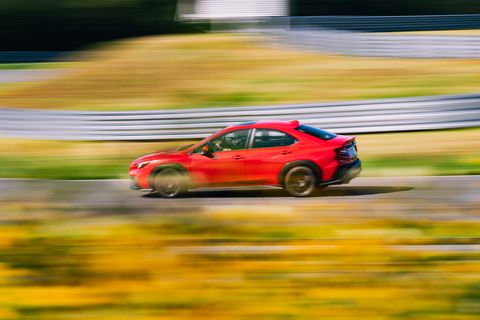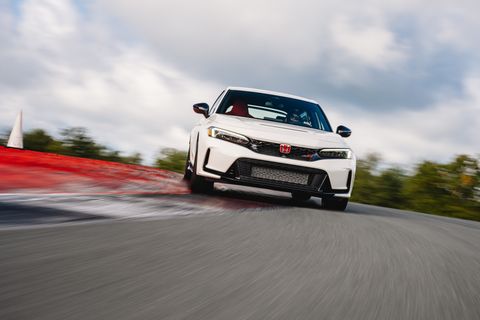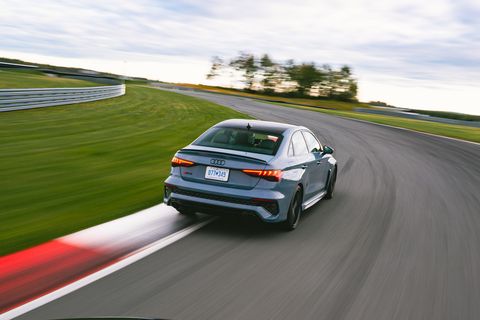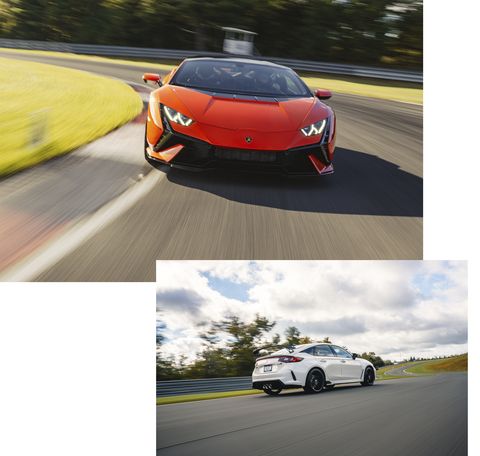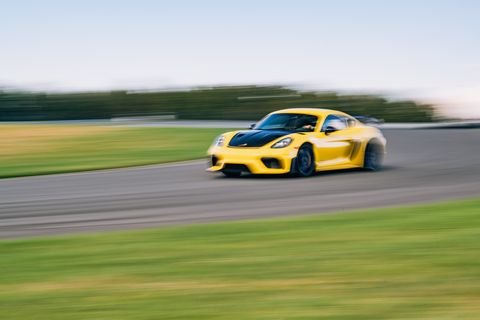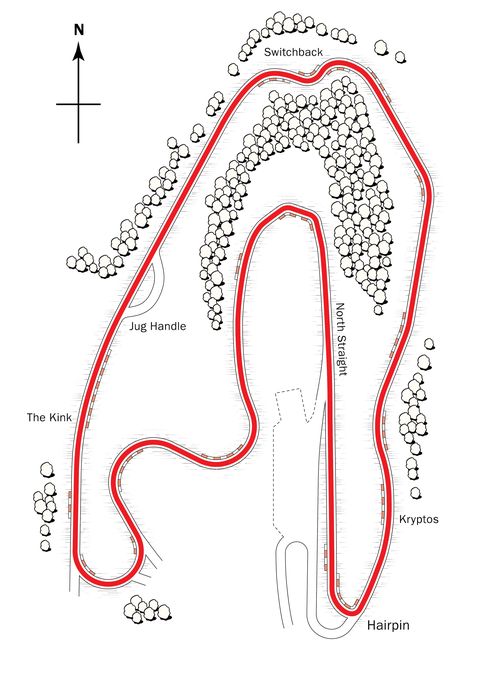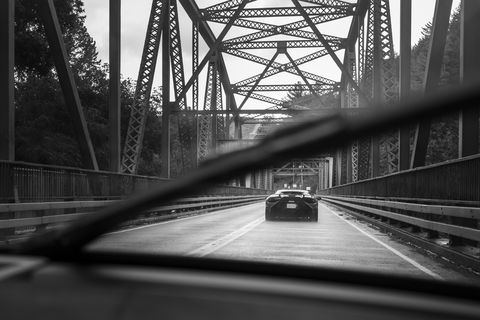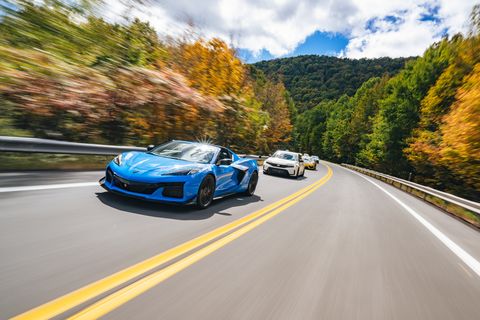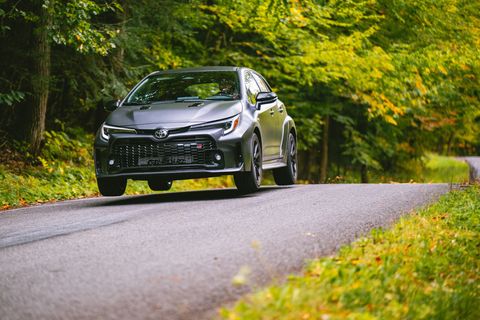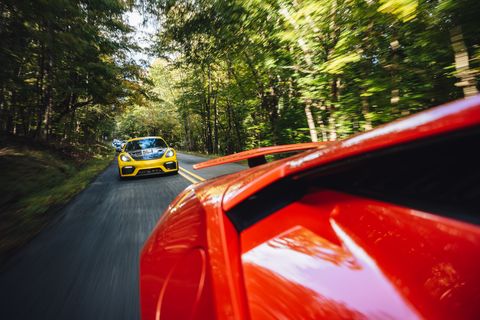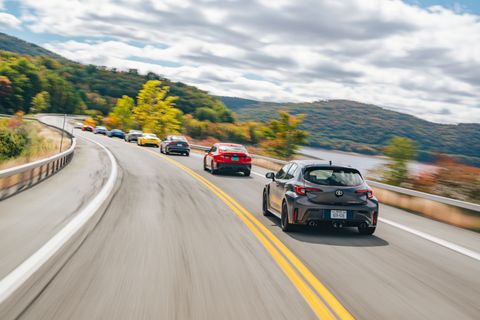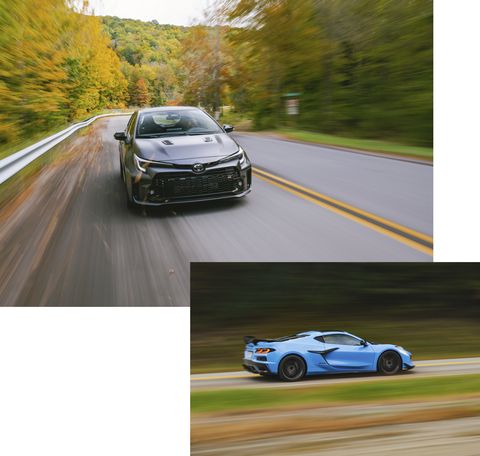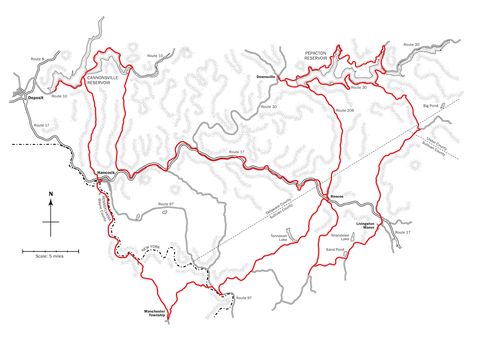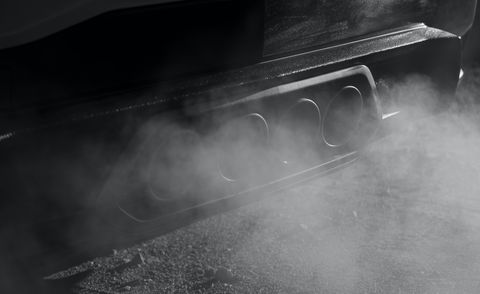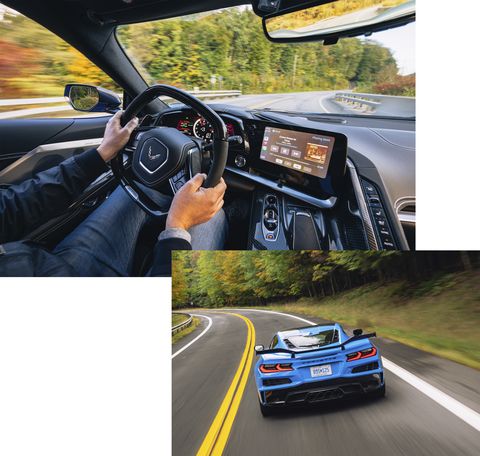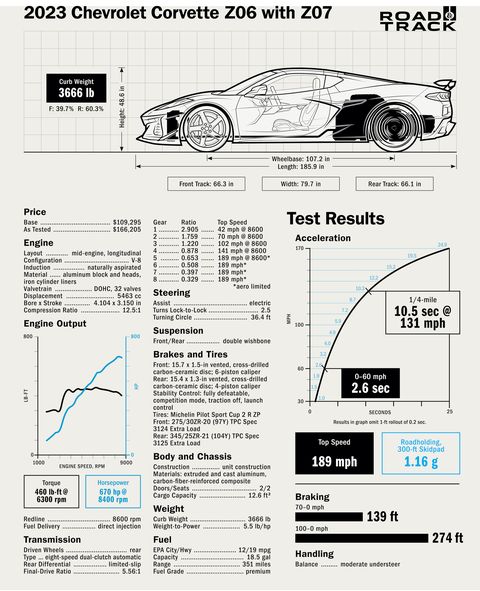Welcome to Road & Track’s 2023 Performance Car of the Year.
From the Editor
The 2023 Performance Car of the Year is the 10th annual testing and ranking of R&T’s favorite new sports cars on the road. In my mind, that’s enough time to call it a legacy. The life cycle of some performance cars is about a decade, at which point technology and taste usually render their platforms obsolete. The Lamborghini Huracán, for instance, is slated to close out its stellar 10-year run in 2024, marking the end of a model that lifted the brand’s sales and performance far beyond expectations. We included one of the last Huracán variants—the $300,000-plus Tecnica—in this year’s test. The legacy of the Huracán is undeniable, but is it PCOTY?
The whole staff flew in from around the country to gather at Monticello Motor Club in blustery upstate New York. We spent a couple of days tearing apart tires on the track, then turned our attention to road performance. Ultimately, it’s not only numbers we’re after but a feeling.
We evaluate a mix. There are showboats like the Lamborghini, as well as performance compacts such as the Toyota GR Corolla and the Honda Civic Type R. We included the Porsche 718 Cayman GT4 RS, the Audi RS3, the Subaru WRX, the BMW M4 CSL, and the new Nissan Z. One of the staff favorites was the Hyundai Elantra N, which bears little resemblance to the base Elantra beyond its platform (for the record, the Hyundai Veloster N won the 2020 PCOTY).
A legendary name that joined us is the new Corvette Z06. Now in a mid-engine configuration, the Corvette has been tearing ass down America’s highways for a decade longer than Lamborghini has been making cars. But does it deserve the 2023 PCOTY? Read on to find out.
—Mike Guy, Editor-in-Chief
The Cars
The Track
A performance car isn’t a race car, but by definition it must perform. So what purpose does the track portion of the Performance Car of the Year competition serve?
Racetracks are, by far, the safest venue for exploiting today’s absurdly powerful, ridiculously grippy performance cars. Track driving takes a thousand distractions and dangers out of the business of driving fast. It focuses the mind.
Racetracks aren’t about ease of ingress and egress, the complexity of a car’s user interface, or ride comfort. They are about speed. More important, they’re about the ease with which a driver can harness that speed and the joy derived from the exercise.
A single driver runs three timed laps in each car, and we note the quickest one here. There is surely time to be shaved from each car’s best lap; that’s not the point. The point is to measure the accessibility of each car’s maximum performance.
The undulating 1.9-mile, nine-turn North Course at Monticello Motor Club in upstate New York is a perfect place to suss that out. The rest of the time during our two track days is at least partly for the staff’s personal joy.
Here are the competitors, considered from slowest to fastest:
The Subaru WRX should compete directly with the GR Corolla and Elantra N; its name is synonymous with budget performance. But this new WRX may be too mature—good for commuting, less good for track days. The brakes were prone to fade, and there’s an obvious focus on road comfort over high-velocity hilarity. The WRX was the slowest of this year’s competitors at 1:34.8.
A tad quicker at 1:33.4 was the new Nissan Z. Sure, it has 400 hp, but it’s also more eager to slide than the Subaru. That’s great for smiles but bad for lap times. Alas, early in our testing, the Z’s suspension suffered damage after hitting a curb on Monticello’s tight switchback after the straight. Every other car hit that curb repeatedly for two full days without a problem, but it put the Z out of the competition almost before it started.
Next is Hyundai’s Elantra N. The N-brand cars have repackaged humble parts into rambunctious driving devices built for character, not numbers. For just under $34,000, the Elantra N is the performance bargain of the moment. This compact sedan shouldn’t be faster than a Z car, but it is.
On track, dive into the braking zone far later than should be comfortable, chuck it over a curb, and get back to power before the front wheels even land. Riotous. Complaints? The six-speed manual is unpleasantly notchy, the brakes can lack composure, and it’s ugly. The Elantra N’s 1:33.0 lap was still beyond respectable, though. “Just feels like a friend,” says senior editor Chris Perkins, “a good friend.”
Toyota’s GR Corolla Morizo Edition is utterly track focused, and $50,995 is a lot of money for a Corolla. This one wears Pilot Sport Cup 2 tires on lightweight wheels. It has short gearing and no back seat. Plus, its turbocharged inline-three kicks out 300 hp and 295 lb-ft of torque. A riot at every turn of the wheel, the all-wheel-drive system helps it rotate midcorner and, depending on the selected torque split, can kick it into a drift. “It’s a car that eggs you on,” says staff writer Brian Silvestro. Toyota has built a modern race car posing as a sensible commuter. And it’s fast, running an impressive 1:32.2.
Honda’s newest Civic Type R takes a familiar formula—a revvy inline-four (now with 315 hp), front-wheel drive, and a slick six-speed manual—and basically perfects it. The last Type R loved to be bounced off curbs and generally driven like you hated it, and the new car is similarly delightful.
This is one of the world’s finest manual gearboxes. Shifts are positive, direct, and slick. The turbocharged engine pulls to 7000 rpm like an excited goldendoodle dragging you to a squirrel. Its willingness to rotate off-throttle and scamper out of a corner on power is a thing of beauty. Front-wheel-drive-hating digital director Aaron Brown even says, “This is the car that could convert me.” Its lap, a 1:31.6 on optional Pilot Sport Cup 2 tires, is far slower than the Z06’s, but it wasn’t any less fun. This is front-drive royalty.
The Audi RS3 was the Monticello shocker. Small, hot Audis have often been fast but aloof with a tendency to bulldoze through corners. The new RS3 is, instead, a delight. It’s a right-size Audi with a connected front end (thanks to the reverse tire stagger, 265s up front and 245s out back), strong-biting brakes, and that giddy 401-hp inline-five engine. Editor-at-large A.J. Baime sums it up: “Understated and pretty kick-ass.” It posted a 1:28.9 lap, and it’ll drift too.
BMW M4 CSL: No words, just letters and a number that mean so much in the 50th year of BMW M. The thing is, “CSL” is usually reserved for cars intended for the road first, track second. The Sport Cup 2 R tires here indicate otherwise. Driven after something exceptionally nimble such as the Cayman GT4 RS, the M4 initially feels boatlike. A thing you sit atop, not in. This 543-hp, lightweight, rear-drive M4 pulls like the gravity on Jupiter.
Lean into it with the traction control turned down, and the M4 CSL is a thrill. It has interstellar speed—the CSL, the Huracán Tecnica, and the Z06 were the only cars to exceed 140 mph—and it demands attention everywhere. You need to be active on the wheel, catching slides constantly on corner exits. The steering is BMW’s new normal: overboosted with little feel yet accurate. Trust it and it rewards. This was our fourth-quickest car, running a 1:24.2. But honestly, it’s a bit boring to drive below its limits. At lower speeds, an all-wheel-drive M4 Competition is nearly as quick and much cheaper.
The Lamborghini Huracán Tecnica is to the Huracán STO as the Porsche GT3 Touring is to the regular GT3. Stripped of its most garish aero addenda, the 631-hp Tecnica keeps its rear-wheel drive, only now with a supposedly more road-tuned suspension. It’s also slightly easier to see out of and a tad more comfortable.
Drive the two Huracáns back to back (yours and a friend’s) and report if there’s a difference. It is as hardcore, raucous, and thrilling as the big-winged STO. The Tecnica was third fastest in this year’s test at 1:23.1 (1.2 seconds slower than the STO last year). Monticello has minor bumps in its heaviest braking zones, and the Huracán moves around quite a bit. It demands a lot of the driver. It might have lost its dorsal fin, but this Lambo is still wild and powerful.
Sounding like a liter superbike, Porsche’s Cayman GT4 RS has the shortest gearing Porsche has ever stuffed into a dual-clutch PDK box. So the 493-hp 4.0-liter flat-six from the 911 GT3 often hits its 9000-rpm redline even on a tight circuit like the North Course. And because Porsche replaced the rear quarter-windows with intakes that feed an airbox just behind your head, the engine is practically inside your brain.
Porsche has always been reluctant to make the Cayman too fast; protesters would storm Stuttgart if the Cayman were swifter than a 911. But with the next-generation Cayman likely electric, to hell with that. Welcome the riot.
Beyond sound and manic acceleration, the Cayman GT4 RS is balanced with a hyperconnected front end that won’t wash wide on power down. “Like a wedge of billet titanium,” senior editor Kyle Kinard says. “It feels as light as it does invincible.” It was the fourth most powerful in our test but ran a 1:22.7, the second-quickest time. However, nearly $200,000 (as tested) is an astronomical price for a Cayman.
There was never any doubt about which car would be the fastest this year. Chevy’s latest Corvette Z06, packing a new 670-hp 5.5-liter flat-plane-crank V-8, was the most powerful car in our test. It had nearly slick Michelin Pilot Sport Cup 2 R tires and the ultra-aggressive Z07 track pack.
The Z06 ran a 1:20.6, easily besting the GT4 RS by two seconds. It’s wide and low, with big aero and fat tires (275/30-R20s up front, 345/25-R21s out back), and it boasts one of the world’s most aggressive engine barks. It should be scary and intimidating. Instead, it’s a trusty partner in speed. Its chassis tuning, extreme braking performance, and behavior on power-down fully exploit the mid-engine platform.
“The Z06 is so awe-inspiring and engrossing that when I got out, I wanted to lie down,” says reviews editor Mack Hogan. The Z06 proved interesting and fun, no matter the pace or driver’s experience. And it wasn’t the only car that came in with near-unanimous praise.
Yes, the track is but one piece of the PCOTY puzzle. The roads through the Catskills could tell a very different story about these cars. Could the aggressive Z07 package that made the Z06 such a track monster ruin it on the road? Would the WRX shine in the real world? And could the Civic Type R, the GR Corolla, and the Cayman GT4 RS follow up impressive lap times with street delight? – Travis Okulski
Monticello Motor Club
The North Course, 1.9 miles
The Lap Times
Numbers don’t rule our test, but they sure help settle sausage-measuring contests. Here are the winners and losers on a timed lap at Monticello.
The Road
The rain is falling hard. Juicy, wobbly droplets crack like rifle shots against the windshield. It’s just past noon on the side of some no-name upstate New York highway, nothing but clear back roads ahead. A crackle issues from the radio.
“You ready to roll?”
We’ve been waiting all year for the chance to turn New York’s autumn splendor into a blur. We’ve gathered the best cars that debuted in 2022, from rorty hatchbacks to bladelike exotics. We dropped them all into a sawdust death pit, then sat back to watch the brawl set off. Engines bark to life, and we kick up our heels for the best-damned test on earth.
There is a line of rare metal trailing behind me, low-slung six-digit wedges with their shouty looks, but for running all out on slick asphalt, there’s no better seat in the house than the Toyota GR Corolla. Perhaps no car stoked more anticipation than this gawky flat-black jukebox, and none are flattered more by a low-grip back road.
“Truly wonderful,” editor-at-large Travis Okulski gushes. “A company that builds some exceptionally boring appliances built a hot hatch with a soul.”
That turbocharged three, connected to trick differentials and all-wheel drive, felt deeply special on track, but the package feels doubly fizzy on these roads where wet leaves and standing water abound.
The Audi RS3 performs the same trick, reeling in cars with twice its $67,690 tested price. This relentless ball of muscle and five-cylinder snarl makes the whole effort of driving fast feel effortless. Road & Track’s staff agrees: The RS3 would make for the best daily driver in the group. Its slick interior feels more elegant than the rest, with the finest infotainment interface on offer. The RS3’s suspension best suits long hauls; its cabin was a favorite for the leggy trips to dinner at the end of each day.
But is it gnarly enough?
Victory at PCOTY requires more than ticking boxes, and to its credit, this sedan ticks many. The RS3 may be Audi’s most hard-nosed compact sedan, but it needs to let more hair down to steal attention among this group.
It’s the same with our bright-red WRX, a competent daily driver with excellent road manners, motivated by the smoothest boxer-four in the business. But for all its competence, the WRX lacks sharpness. We’re not sure whether an STI version will ever return, but boy, do we miss that pink badge more than ever.
The Elantra N gets far closer to the mark, sharper and quicker than the WRX, with a grumpy exhaust note to boot. It handles like a stretched version of our 2020 PCOTY-winning Veloster N, offering the same pep from its 276-hp turbocharged inline-four. Some staff even preferred the Elantra N to the Veloster.
“Value-wise, this blows everything out of the water,” staff writer Brian Silvestro says. “Makes everything else in the test seem like it’s taking itself too seriously.”
But in search of performance, this sport compact left some civility on the table. Executive editor Daniel Pund notes the ride is flintier on the road than you’d like, with a drab interior reminding you how Hyundai shaves the Elantra N’s MSRP down to $33,745. From nearly every angle, it’s another incredible effort from Hyundai. Well, so long as you’re not looking directly at it.
“Shame about the looks,” Pund laments, pointing to the Elantra’s techno–Cheshire Cat mug.
We still haven’t wrapped our brains around the M4’s nose job, either. That flared pig’s snout that overtook the 4-series is spreading throughout BMW’s lineup. Yet the real curiosity is the badge affixed to this M4’s trunk. The letters “CSL” have graced only the lightest, most focused versions of the best compact BMWs ever built, legends like the E46 M3 CSL and E9 3.0 CSL “Batmobile.”
Like other M4s, the CSL plays drift missile in every corner, with accurate steering and a firm, unflappable chassis. When the road is dry and the tires warm, no supercar will shake the CSL from its mirrors. But despite a bump in power, a bit of weight shaved off, and some visual faff, the M4 CSL doesn’t do enough to separate itself from the standard M4.
We want the old E46 CSL tricks applied to the new M4: even less sound deadening, an idiosyncratic intake note, zero embellishments, and no A/C or radio or lighted CSL badges in the headrests. Every component of a CSL should make sense when viewed through the uncompromising lens of the phrase “The Ultimate Driving Machine.” This CSL couldn’t clear that hallowed bar.
Finding that Goldilocks mix proves elusive. On paper, the Lamborghini Huracán Tecnica got everything right. Last year we commended the Huracán STO’s frankly batshit commitment to theater, equipped as it was with perhaps the loudest exhaust note we’ve ever heard on a road car, plus fixed-back carbon buckets and a buzzing character best downed in a shot glass.
Lamborghini kept the good bits of the STO but rounded off some of its sharpest edges to create the Huracán Tecnica. The Tecnica preserves the STO’s fantastic steering feel, a pointy, get-there-now system that fires the car at every apex with mere twitches of the steering wheel. Plus, the V-10 engine’s shriek still hits harder than a bucketful of knuckles.
But the STO’s brutal suspension tuning isn’t eased nearly enough. A long day at the wheel of the Tecnica takes more out of you than a week on the road in a regular car. It’s thrilling on a racetrack but draining on a back road.
Somehow the most hard-core Cayman ever built, the GT4 RS, nosed just far enough toward sanity to avoid the Tecnica’s fate, with seats and suspension comfortable enough to keep us from reaching for the ’roid cream. Barely.
The GT4’s captivating engine may have allowed us to take more punishment than we’d normally tolerate. That shrieking 4.0-liter 9000-rpm flat-six borrowed from the GT3 is a zenith, peerless in its charisma at redline. We’re intoxicated by the engine’s full soundtrack, including the ripping rush of air just over your shoulder, as the engine pulls in the atmosphere through inlets in the quarter-windows.
Sound isn’t the Civic Type R’s strong suit, but on these tight country roads where uncertainty lurks, you can’t stretch any car’s legs enough to gap the Honda. Plus, it does everything else so well. Its interior is a master class in simple design, with the best seats, the best gearbox, (arguably) the best steering feel, and the best shift action of any car in the test. And it has three pedals to work.
Whether hot or cold, wet or dry, the new Type R brings joy in every two-lane corner and down any winding back road. Its firebomb engine and firm yet comfy chassis tuning contribute to a car with peerless versatility that sacrifices nothing on the altar of practicality. Both track rats and soccer dads could drive away from this test in the new Civic Type R and never look back in jealousy. It’s that good.
Our final contestant is the one you’ve probably been dying to read about. An engineer told me the Corvette Z06 could stick wide-open through the Nürburgring’s infamous Fuchsröhre corner, generating two lateral g’s of grip while simultaneously suffering two vertical g’s of compression.
But on these roads, there’s not a foxhole corner in sight. Could something this balls-out engage us on a back road where there are no stopwatches? The answer shouts back from the Z06’s raspy exhaust: “Duh, idiot. I’m still a Corvette.”
More than one editor called the Z06 a down-home Ferrari, its flat-plane V-8 scream reminiscent of the 458 Italia. We never ran out of excuses to wring that engine out to redline, our mouths spread into wide, stupid grins at the audacity of the thing, the sheer American-ness of it all.
Its dual-clutch automatic couldn’t shift quite as quickly as Porsche’s PDK, but it did click through gears smoothly and predictably. The Z07 package brought more spring to the party, but the Vette’s magnetic dampers are calibrated so superbly that you could easily live with the Z06 as a daily.
As the decision point crept closer, our test winding to an end, the editors circled back to linger by one of the top three contenders, draping their elbows over the GT4 RS’s ironing-board wing, lounging in the Civic’s perfect seats, taking the Z06 on one last rip down the road—anything to vanquish indecision.
But ultimately, only thimblefuls of dissent poured into the discussion. A nearly unanimous champion emerged. Maybe it was an obvious choice; one car felt destined for the crown. Its performance served as a rolling affirmation of that destiny. Our ultimate champion on the track proved just as exciting on the road.
As difficult choices go, this was an easy one. – Kyle Kinard
The Catskills Loop
Upstate New York, 192 miles
Our test loop pairs plenty of glassy high-speed sweepers with gnarled greasy asphalt bends. Here you’ll encounter enough pavement to suss out any sports car. The breathtaking river views are just a bonus.
The Champ
The new 2023 Z06 is the Corvette unshackled. It’s beholden to neither heritage nor history nor Chevrolet itself. If it shares any part with other GM products, it’s something incidental, like a windshield-wiper motor or a door latch. The engine is positioned where the engineers have long wanted it, and that engine is one of which they’ve long dreamed. It proved itself on track before it made it to the road. After 70 years, this thing has all the right stuff. It is the Corvette in full.
“I hate to use the term ‘compromise,’” says Tadge Juechter, executive chief engineer for the Corvette, “because every car is a balance. If you look at the history of the Z06 in the modern era, it has walked more extreme with each generation. We’ve taken the formula and made it more vibrant, more powerful, more focused.”
Like the C6 and C7 Z06 models, this C8 version was planned alongside the standard Stingray model. The C6 and C7, however, were evolutionary designs that refined the C5 paradigm—engine in front, transmission in back. The C8’s mid-engine packaging enables it to accommodate a wide, double-overhead-cam 32-valve V-8 that would otherwise have to snake up through a front-engine car’s frame rails and bodywork at the plant in Bowling Green, Kentucky.
“One reason why we had such free rein on the LT6 with the double-overhead cams and the big intake manifold is that we didn’t have to worry about someone having to look over the hood,” says GM’s global small-block chief engineer, Jordan Lee. “This engine in a front-engine car? You’d barely be able to see through the windshield.”
Lee contends this is a small-block V-8 because “a small-block is an engine designed and developed by the small-block team.” And it does share the 4.4-inch bore spacing every Chevrolet small-block V-8 has had since 1955. But no. It’s not a small-block. The LT6 is really a hand-built 670-hp 5.5-liter race engine.
It’s the first GM engine developed solely with a dry-sump oiling system. The rev-friendly oversquare dimensions—big 4.10-inch cylinder bores and short 3.15-inch crank strokes—stand in contrast to the long levers needed for torquey truck V-8s. And then there’s the awesome respiration of a flat-plane crankshaft. “We often refer to it as two four-cylinder engines in a fistfight,” says Lee.
And 5.5 liters is huge displacement for a flat-plane V-8. Maybe the largest ever. “Most flat-planes are pretty small displacement,” Lee adds. “We did not want to give up displacement because we still wanted to have some respectable low-speed torque.” Also, 5.5 liters is, not coincidentally, the maximum displacement allowed for the FIA’s World Endurance Championship LMGTE class. The LT6.R, the LT6’s race brother, has been in the C8.R race car since the 2020 season. “We engineered the two engines as a team,” says Lee. The team tore down the LT6.Rs after races, and that experience went into the LT6. “The racing helped a ton,” concludes Lee.
There are no demon tweaks in the LT6 that tame the paint-shaker vibrations of the flat-plane layout. Instead, the short stroke and lightweight rotating mass keep the vibrations within parameters set using the Ferrari 458 as a benchmark. That’s one hell of a bench.
Start the cold Z06, and it inhales a massive glob of air, whirs a moment, then bursts to high idle with a sound that’s half Pro Stock, half Indy car, and half North American mountain lion. With volumetric efficiencies exceeding 100 percent, this engine deserves three halves. The rest of the C8 is wonderful, but the LT6 elevates it to glorious.
When the Tremec eight-speed dual-clutch transmission engages a gear, the LT6 growls in anticipation, then rips up toward its 8600-rpm redline at the touch of the throttle. No engine in the history of General Motors or Planet Earth has combined a large-displacement American snarl with rev-happy Italianate giddiness like this one. Like a morphine and Tetris cocktail, it’s addictive.
The Z06 is rear-drive, but its 345-millimeter back Michelin tires bite into tarmac with viral appetite. With the Z07 package, those Michelins are of the extra-hungry Pilot Sport Cup 2 R variety. The car reaches 60 mph in 2.6 seconds and runs the quarter-mile deep into the 10s, and the steering turns in like Patton pivoting to chase the Germans out of the Ardennes Forest. The body is 3.6 inches wider than a standard Stingray to cover that big rubber, but so aerodynamically optimized that you can feel the Z06 planting itself on track as speed grows. Apart from the doors, each body panel at and below the beltline is unique to the Z06, but the structure underneath is the same as the Stingray’s.
With that in mind, this isn’t a car that delivers a velveteen ride. And the cockpit privacy divider separating the driver and passenger is still there.
Mechanically, there’s never been less Chevrolet in a Corvette. But spiritually? The Z06 development process recalls the “Mystery Motor” 427-cid V-8 Chevrolet campaigned (with Smokey Yunick, among others) in NASCAR during 1963. That engine evolved into the 1965 Corvette L78 425-hp 396-cid “big-block” and all the other big-block V-8s. And the LT6’s bore-to-stroke ratio parallels that of the short-stroke DZ302 small-block in the 1967–69 Camaro Z/28 for the SCCA Trans-Am competition. The new Z06 isn’t beholden to past Chevys, but its existence honors history.
Finally, the new Z06 is a Chevy in several ways that matter. First, as Aaron Link, lead development engineer for the Z06, notes, “If you need help with your Corvette, there are 3000 dealers in this country to help you.” Second, coupe or convertible, the Z06 can be optioned with restraint or indulgence like any Corvette. Most important, prices for the Z06 coupe start at $109,295, a raging bargain for something that feels so exotic.
That mix of home-team decency and breakneck speed stole our hearts. The engine’s redline rush delivered on decades of anticipation. For its staggering track performance and engagement on the road, we anoint the 2023 Chevrolet Corvette Z06 our champion. – John Pearley Huffman
